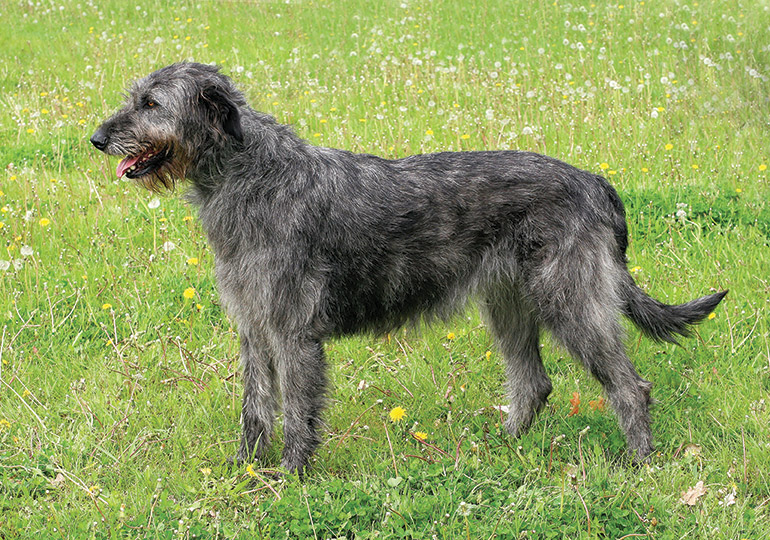Breeds
Irish Wolfhound

GROUP 4 - HOUNDS
History
The Irish Wolhound has a history that stretches back to the times of the Celts and perhaps beyond. It is thought that the Celts brought the tall Greyhound-like hunting dog to Ireland, with its original purpose being to hunt and kill wolves, which it did with such success as to cause the extinction of the wolf in the British Isles.
Temperament
The Irish Wolfhound can be wilful and destructive as a puppy if not given sufficient attention to occupy its curious mind. It is loyal, friendly and an independent thinker, as it was bred to make its own decisions while hunting.
Obedience training is mandatory, given the size the breed grows to as an adult. It is usually quick to learn and does not respond well to overly long training sessions. Consistent, short repetitious training over a period of weeks and regular application of the rules, will see the best possible relationship develop with the Hound.
Appearance
The typical Irish Wolfhound is a tall, powerful, double-coated Hound with a double suspension gallop at full pace that is certainly a magnificent sight to see. It was bred to chase, catch and bring down large animals, so the breed has to have strength, speed and the stamina to catch and kill a wolf.
While it should not be quite so heavy or massive as the Great Dane, it generally resembles the Deerhound. The Irish Wolfhound is of a great size and maintains a commanding appearance: muscular, strong and gracefully built.
Health
If the Irish Wolfhound should suffer from health problems before its time, it will most often be to bone cancers, heart problems or bloat. Other breed-related health problems are port-systemic shunt, which is testable, and OCD (shoulder or elbow joint problems).
The breed-guardian breeders have made concerted efforts to reduce the occurrence of these health problems, especially where there seems to be an identifiable genetic basis or at least a trend.
The Irish Wolfhound’s lifespan, like most giant breeds, is six to eight years on average. However, ages of over 10 are not unheard of, given good management and a healthy dose of luck.
Maintenance
The Irish Wolfhound is a low maintenance dog once it has reached maturity, at around two to three years of age.
As an adult, it tends to spend 90 per cent of its day finding a nice cosy spot to snooze, especially if it can keep an eye on you at the same time. A weekly brush and monthly wash is a good guide to follow. It does shed hair, especially coming into spring when it sheds the thickest part of its winter coat.
Suitability
A fully fenced yard is a must. The breed generally doesn’t make a good guard or security dog, although its size will deter most people and sometimes it can be protective of house and family. The Irish Wolfhound makes a good family pet and enjoys a daily walk.
Words: Stephen & Soile Gendle
Image: Capture Light. Shutterstock
In Conclusion
Now you know a little about the Irish Wolfhound you may have think that this is the dog for you. Before you make a decision, please make contact with the breed club or your State controlling body for purebred dogs. They will be able to give you information about available puppies and also suggest dog shows where you can see the breed and speak to breeders. In this way you will gain a better perspective of the Irish Wolfhound and its needs and whether this breed would suit your lifestyle.
Breeders






